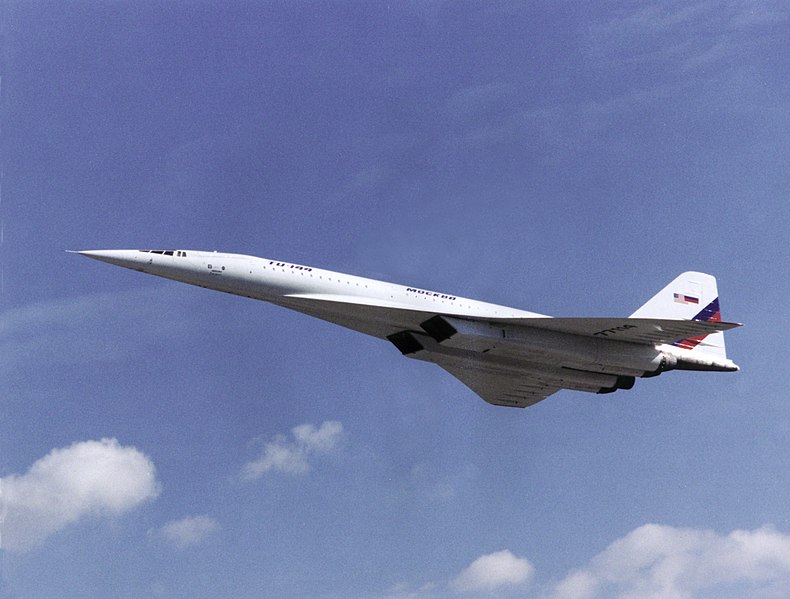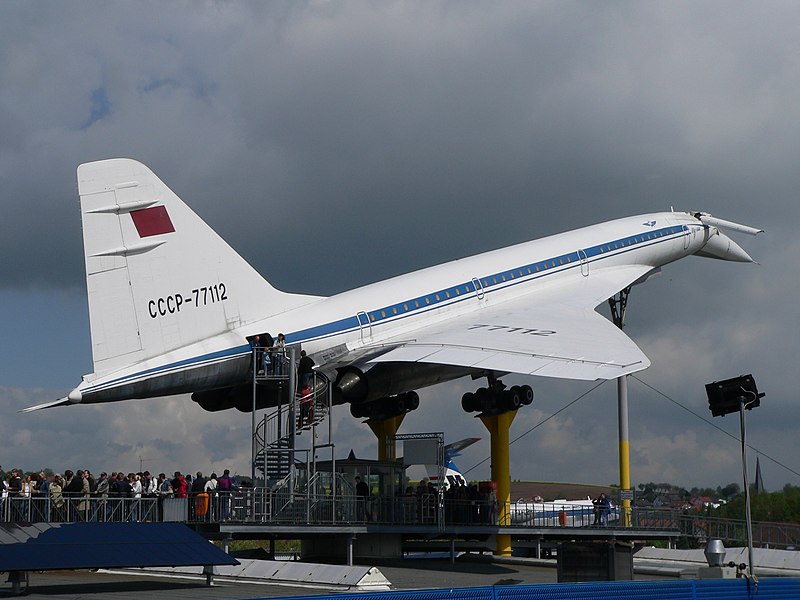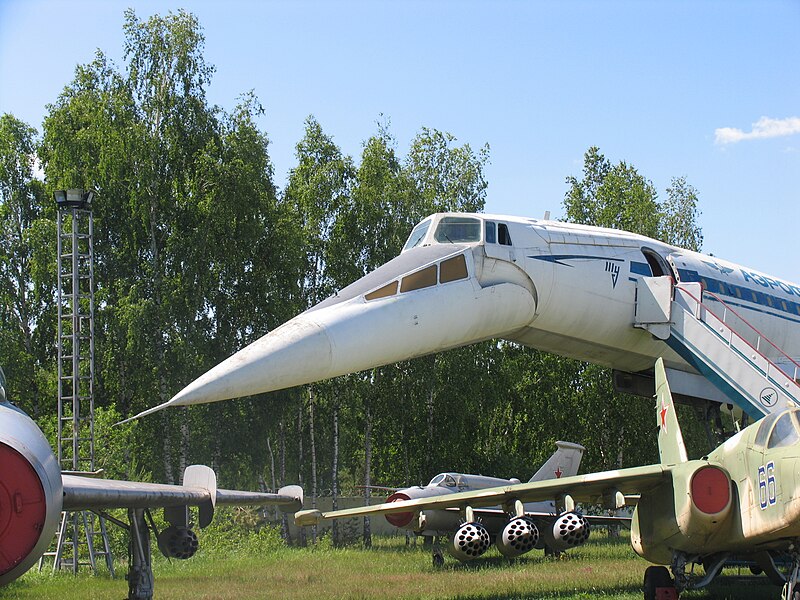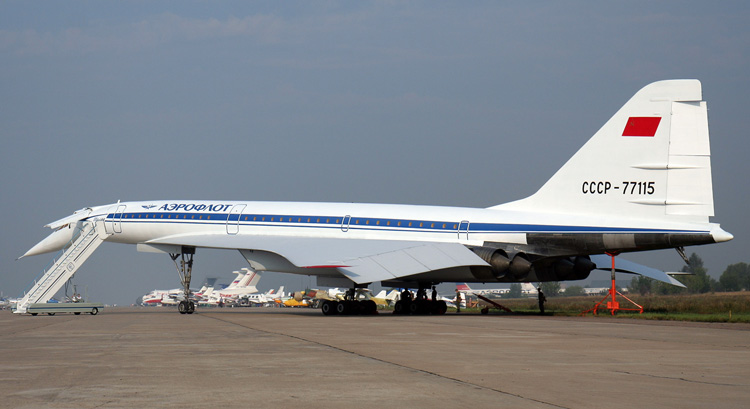
Tu-144 - Soviet supersonic airliner, Tupolev developed in the 1960s.Tu-144 the world's first supersonic airliner, airlines have ever used for commercial traffic.
The first flight of the Tu-144 took place on December 31, 1968 (the design bureau's test performed Tupolev Edward Elyan), that is, two months earlier, "Concord." Tu-144 is also the first in the history of passenger airliner to break the sound barrier, it happened (June 5, 1969) at an altitude of 11,000 feet. The following symbolic milestone of Mach 2 aircraft overcame May 25, 1970, flying at an altitude of 16,300 meters at a speed of 2150 km / h The aircraft combined the huge number of advanced development and design solutions. For example, a retractable in-flight canard (CHR), which can significantly increase agility and reduce speed during landing. Tu-144 could sit down and take off at 18 airports in the USSR, while the "Concord", the landing speed of which was 15% higher for each airport required a separate certificate for the land. According to some experts [streamlined expression], if the engines, "Concord" were placed in the same way as the Tu-144, the crash July 25, 2000 would not have happened (because of the fact that the engines of the Tu-144 are not separated on the wing, as the "Concord", and concentrated in the fuselage, resulting kerosene would not have fallen into the stream of hot gases and the fire did not have). However, according to the channel National Geographic, in the transmission of "Seconds from Disaster. 01. Concorde Crash." Ignited the fuel spill occurred due to short circuit, and not because of falling into a stream of hot gases.
In the design was done enormous work. In particular, the simulated wing
with full-scale tests on specially prepared for the MiG-21I (a flying
laboratory for the study of wing Tu-144).
June 3,
1973 Tu-144 crashed 77 102 number during the demonstration flight at Le
Bourget. All six crew members (Hero of the Soviet Union honored
test pilot Mikhail Kozlov, test pilot, VM Molchanov, navigator G. N. Bazhenov,
Deputy Chief Designer, Engineer, Major-General VN Benders, the chief engineer B .
A. Pervukhin and flight engineer AI Dralin) died. According to the version
that appeared after the crash, the cause of the disaster is considered too
abrupt maneuver that the crew had to make in order to avoid collision with the
French suddenly appeared "Mirage" (a task which the pilot was to
photograph Soviet Tu-144 in flight), the violation of the control system or the
inadmissibility of the sameairframe structures for the maneuver, which the crew
tried to do. The true causes of the accident was classified, which led to
a stream of speculation on this subject. So in 2005 the film by Alexei
Polyakov, "The Battle for supersonic. The truth about the Tu-144
"Edgar Krupyansky (at the time of Tu-144 - deputy head of the test base
Tupolev) said about them:" On the machine (the Tu-144) were the units that
were first put on board for the test. " Block automatic control of
the experimental apparatus was disconnected and sealed before the demonstration
flights. Fault in the accident pilots do not. It was also suggested
version: one of the pilots in the cockpit using amateur film camera, and she
dropped out of the hands, shifted and blocked the yoke, resulting in the
aircraft performed a maneuver on the transcendental mode and collapsed. In
the newsreel shots you can see that the fuselage of the Tu-144 because of an
overload broke in two places.
The crew of the Tu-144 number 77 102 was buried in the Novodevichy Cemetery.
The crew of the Tu-144 number 77 102 was buried in the Novodevichy Cemetery.
Nevertheless, the Tu-144 was to make
regular flights. The first workingflight was made December
26, 1975 on the route Moscow - Alma-Ata,where the
plane carried mail and parcels, and on November 1, 1977in the
same direction, and began passenger
service. Beginningoperation of passenger Tu-144 was
dedicated to the 60th anniversary of the
October Revolution. Flights performed only two
aircraft - №77109 and № 77110. Aeroflot pilots flew only
as co-pilots, crewcommanders have always been the
same test pilots Tupolev. Ticketsfor this
aircraft cost 83 rubles, while the ordinary subsonic
aircrafttickets to Alma-Ata cost 62 rubles.
Commemorative Coins of Russia, dedicated to the
Tu-144. RR 1, Silver.
But the commercial career of the Tu-144 was short-lived, its operation was unprofitable. Due to the forced high ticket prices, nearly one and a half times higher than normal, load boards were very low, leading to a denial of service on passenger routes of Aeroflot. June 1, 1978, just seven months after the start of commercial operation, Aeroflot permanently ceased supersonic passenger flights. The immediate reason for the termination of passenger flights was the crash of the prototype Tu-144 that occurred the previous week (see below).
Subsequently, the Tu-144 was only used for freight traffic between Moscow and Khabarovsk. In total, the Tu-144 made 102 flights under the banner of Aeroflot, 55 passenger (were transported 3194 passengers).
Production aircraft were deployed on the Voronezh plant number 64.
By the time of the refusal of the operation was built 16 Tu-144, which made a total of 2556 sorties and 4110 hours flown (among them the most, 432 hours flown onboard number 77114). The construction of four more planes have not been completed.
Later, the Tu-144 made only a few test flights and flights with a view to establishing world records.
But the commercial career of the Tu-144 was short-lived, its operation was unprofitable. Due to the forced high ticket prices, nearly one and a half times higher than normal, load boards were very low, leading to a denial of service on passenger routes of Aeroflot. June 1, 1978, just seven months after the start of commercial operation, Aeroflot permanently ceased supersonic passenger flights. The immediate reason for the termination of passenger flights was the crash of the prototype Tu-144 that occurred the previous week (see below).
Subsequently, the Tu-144 was only used for freight traffic between Moscow and Khabarovsk. In total, the Tu-144 made 102 flights under the banner of Aeroflot, 55 passenger (were transported 3194 passengers).
Production aircraft were deployed on the Voronezh plant number 64.
By the time of the refusal of the operation was built 16 Tu-144, which made a total of 2556 sorties and 4110 hours flown (among them the most, 432 hours flown onboard number 77114). The construction of four more planes have not been completed.
Later, the Tu-144 made only a few test flights and flights with a view to establishing world records.
May 23, 1978 was the second collapse of an
experimental model ofthe Tu-144. During a test flight of
the upgraded version of the aircraft,the Tu-144 (№ 77 111) after
the ignition of fuel in the area of the
nacelle third power plant because of the destruction of the fuel
pipe, smoke in the cabin crew and disabling two engines made
an
emergency landing on the village of Ilyinsky, near from the Moscow
region town Egorievsk.
After landing, the cockpit through the window left the plane crew commander, VD Popov, and EV-pilot and navigator Elyan VVVyazigin. Engineers were in the cabin VM Kulesh, VA Isaev, VNStolpovskiy left the plane through the front door. Flight engineers A.Nikolaev and VL Venediktov jammed in the workplace deform whenplanting designs and died.
After landing, the cockpit through the window left the plane crew commander, VD Popov, and EV-pilot and navigator Elyan VVVyazigin. Engineers were in the cabin VM Kulesh, VA Isaev, VNStolpovskiy left the plane through the front door. Flight engineers A.Nikolaev and VL Venediktov jammed in the workplace deform whenplanting designs and died.
From 1995 to 1999, a significantly modified Tu-144D (№ 77
114)under the name of the Tu-144LL ("Flying Laboratory") used
by the U.S. space agency NASA for research in the field of
high-speedcommercial flights in order to develop a plan to build a
new modernsupersonic passenger aircraft. At the Tu-144LL engines
were installed NC-32 (similar to those used on the Tu-160) due
to lack ofserviceable NC-144 and RD-36-51, various sensors
and test control and recording equipment.
Were
constructed and refurbished:
- Tu-144 ("044") - the first prototype of the number of 68 001 NK-144.Very different in many elements of design (shape and profile of the wing, the placement of engines and landing gear, landing gearstructure, length and shape of individual elements of the fuselage,crew ejection seat, fire back hatches to exit ejection seats and other features) on the production of pre and and is more a separate model of the aircraft.
- Tu-144 ("004") - pre-production prototype of the number of 77 101NK-144.
- Tu-144S - serial (experienced and exploited) aircraft with engines NK-144A.
- Tu-144 - pilot production aircraft with RD-36-51.
- Tu-144LL - prototype Tu-144 with engines NK-32.
- Tu-144 ("044") - the first prototype of the number of 68 001 NK-144.Very different in many elements of design (shape and profile of the wing, the placement of engines and landing gear, landing gearstructure, length and shape of individual elements of the fuselage,crew ejection seat, fire back hatches to exit ejection seats and other features) on the production of pre and and is more a separate model of the aircraft.
- Tu-144 ("004") - pre-production prototype of the number of 77 101NK-144.
- Tu-144S - serial (experienced and exploited) aircraft with engines NK-144A.
- Tu-144 - pilot production aircraft with RD-36-51.
- Tu-144LL - prototype Tu-144 with engines NK-32.
Comparative table of characteristics:
Tu-144, various
modifications
|
Concorde
|
||||
Tu-144
("044")
|
Тu-144S
|
Тu-144D
|
Тu-144LL
|
||
Technical
characteristics
|
|||||
Equipage,
persons
|
4
|
3
|
|||
Lenght, m
|
59,40
|
65,70
|
61,66
|
||
Height, m
|
12,25
|
12,50
|
12,2
|
||
Wingspan,
m
|
27,65
|
28,00
|
28,80
|
25,60
|
|
Wing area,
m²
|
438
|
503
|
507
|
358,6
|
|
Maximum
takeoff weight, kg
|
180 000
|
195 000
|
207 000
|
203 000
|
185 000
|
Payload
mass, kg
|
12 000
|
15 000
|
13 380
|
||
Fuel mass,
kg
|
70 000
|
98 000
|
95 000
|
95 680
|
|
Engines
|
|||||
Numbers
|
4
|
||||
NK-144
|
NK-144A
|
RD-36-51А
|
NK-32-1
|
Olympus-593
|
|
Maximum
thrust, kN
|
171,6
|
178,0
|
196,1
|
245,0
|
170,0
|
Supersonic
thrust, kN
|
127,5
|
147,0
|
137,5
|
||
Perfomance
characteristics
|
|||||
Maximum
speed, km/h
|
2 430
|
2 500
|
2 285
|
2 500
|
2 330
|
Cruising speed (supersonic), km/h
|
2 300
|
2 200
|
2 120
|
2 300
|
2 150
|
Landing
speed, km/h
|
270
|
295
|
|||
Practical range (fully load), km
|
2 920
|
3 080
|
5 330
|
4 000
|
|
Service
ceiling, m
|
20 000
|
18 300
|
|||
Run
lenght, m
|
2 930
|
||||
Path
lenght, m
|
2 570
|
||||
 A total of 16 machines were built: board
number 68001, 77101,77102, 77103, 77144 (formerly 77104), 77 105, 77106, 77107,77108, 77109, 77110, 77111, 77112, 77113, 77114 and 77115. One
last built car (serial number 9.2, onboard 77 116)
remained unclaimedeither MAP or MCA, and stood for
a long time in the Voronezh aircraft factory, and eventually was
cut [8]. In addition, it collected a few Tu-144 airframes for
ground testing.
A total of 16 machines were built: board
number 68001, 77101,77102, 77103, 77144 (formerly 77104), 77 105, 77106, 77107,77108, 77109, 77110, 77111, 77112, 77113, 77114 and 77115. One
last built car (serial number 9.2, onboard 77 116)
remained unclaimedeither MAP or MCA, and stood for
a long time in the Voronezh aircraft factory, and eventually was
cut [8]. In addition, it collected a few Tu-144 airframes for
ground testing.Remaining in flying condition does not currently exist. Almost fully staffed parts and can be restored to flying condition collars Tu-144LLnumber 77 114, TU-144D number 77 115 and TU-144S number77110.
In restorable condition:
- Tu-144LL number 77,114, which was used for testing by NASA,
is stored at the airfield in Zhukovsky.
- TU-144 77 115 number is also stored at the airfield in Zhukovsky. In 2007, TU-144D number 77 115 was re-painted in accordance with the historical pattern of color and put on public display at theMAKS-2007, and at MAKS-2009 and MAKS-2011.
- TU-144S number 77,110 in the aviation museum in Ulyanovsk
Aircraft number 77114, is likely to be installed as a monument or on display at the airfield in Zhukovsky. In 2004-2005. to them were committed by some of the sale of scrap metal, but the protests of the aviation community have not given this to happen, although the risk ofthis outcome is not completely eliminated.
There was a project www.maks2007.com preparing to fly the TU-14477 115 number at the MAKS-2011 www.aviasalon.com flight toSochi in 2014.
- TU-144 77 115 number is also stored at the airfield in Zhukovsky. In 2007, TU-144D number 77 115 was re-painted in accordance with the historical pattern of color and put on public display at theMAKS-2007, and at MAKS-2009 and MAKS-2011.
- TU-144S number 77,110 in the aviation museum in Ulyanovsk
Aircraft number 77114, is likely to be installed as a monument or on display at the airfield in Zhukovsky. In 2004-2005. to them were committed by some of the sale of scrap metal, but the protests of the aviation community have not given this to happen, although the risk ofthis outcome is not completely eliminated.
There was a project www.maks2007.com preparing to fly the TU-14477 115 number at the MAKS-2011 www.aviasalon.com flight toSochi in 2014.
In the museums:
- TU-144S number 77,106 in the Air Force Museum in Monino near
Moscow
- TU-144 77 110 number in the aviation museum in
Ulyanovsk
- TU-144D number 77112 in the Museum of Technology in Sinsheim(Germany)
is the most high quality restored instance. Installed next
to the French "Concorde".
In stored:
- TU-144 77 107 number is stored in the Kazan Aviation
Institute [1]
- TU-144 77 108 number is stored in the museum of the
SamaraAerospace University [2] [3]
Didn't survive planes:
- TU-144 crashed number 77 102 June 3, 1973 during
ademonstration flight at Le Bourget.
- TU-144 because of the number 77 111 of ignition in air crash
landednear Egorievsk (the plane was completely destroyed,
killing twopeople).
The remaining aircraft were dismantled or cut non-ferrous metals
inthe 90s.
Tu-144 in popular culture
In the cinema
Tu-144 was shown in the film "Mimino." According to the scenario, he flew to New Delhi and San Francisco.
Was shown at the end of the children's film "A drop in the sea" (Studio them. Gorky, 1973).
Showing Tu-144 had complete movie "Unbelievable Adventures of Italians in Russia". It was his rise has been "frozen" on the background of the closing credits of the film. But, at the urging of party leaders, these frames are replaced by personnel taking off IL-62. [Citation needed 428 days] A year before the film Tu-144 crashed just at Le Bourget.
Was shown at the beginning of the movie "The Tale of the human heart" (Mosfilm, 1974).
It was shown in the film "Poem of the wings" (Mosfilm, 1979).
In computer games
In the official publications of the popular flight simulation, such as Microsoft Flight Simulator, X-Plane and Flight Gear, Tu-144 is not provided. However, a group of enthusiasts produced model Tu-144 as a supplement to Microsoft Flight Simulator 9. The prototype aircraft was selected number 77 115. Work is also underway to adapt the model for other simulators. The model is sufficiently high quality of study details. In the model implemented such features Tu-144, as dipping the nose fuselage, aerodynamic front retractable wings, control centering by pumping fuel during the transition to supersonic flight mode
In the cinema
Tu-144 was shown in the film "Mimino." According to the scenario, he flew to New Delhi and San Francisco.
Was shown at the end of the children's film "A drop in the sea" (Studio them. Gorky, 1973).
Showing Tu-144 had complete movie "Unbelievable Adventures of Italians in Russia". It was his rise has been "frozen" on the background of the closing credits of the film. But, at the urging of party leaders, these frames are replaced by personnel taking off IL-62. [Citation needed 428 days] A year before the film Tu-144 crashed just at Le Bourget.
Was shown at the beginning of the movie "The Tale of the human heart" (Mosfilm, 1974).
It was shown in the film "Poem of the wings" (Mosfilm, 1979).
In computer games
In the official publications of the popular flight simulation, such as Microsoft Flight Simulator, X-Plane and Flight Gear, Tu-144 is not provided. However, a group of enthusiasts produced model Tu-144 as a supplement to Microsoft Flight Simulator 9. The prototype aircraft was selected number 77 115. Work is also underway to adapt the model for other simulators. The model is sufficiently high quality of study details. In the model implemented such features Tu-144, as dipping the nose fuselage, aerodynamic front retractable wings, control centering by pumping fuel during the transition to supersonic flight mode








Nice post. I have fully read the post. Thanks for sharing it. aircraft sale
ReplyDeleteVery cool !
ReplyDelete